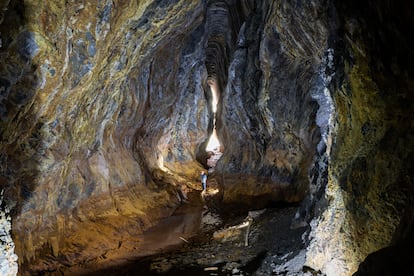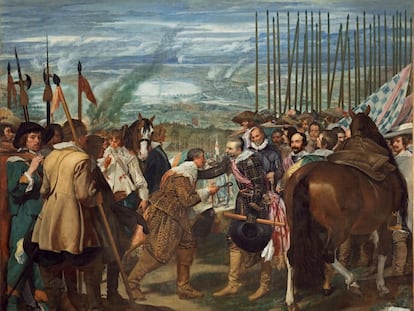Where did the Romans get their gold?
The Spanish National Research Council has revealed a 500-mile network of canals that was built by the Roman Empire. This hydraulic project was used to extract 9,000 pounds of gold from Las Médulas, a mountainous region in the province of León


Emperor Caesar Augustus – also known as Octavian – didn’t simply found the Roman Empire. He also performed the very difficult task of stabilizing its monetary system.
During his reign, gold and silver coins came to have a standard value. The final conquest and pacification of all of Hispania – the Roman name for the Iberian Peninsula – following the Cantabrian-Asturian wars (29 to 19 BC) gave the Empire access to abundant gold deposits throughout the northwest of modern Spain. Still, getting the metal out of the mountains and valleys was easier said than done.
The engineers of Rome realized that water was essential to perform this vast mineral extraction. Subsequently, they organized the construction of a hydraulic network, with numerous canals and reservoirs.
A team made up of 20 individuals from public and private institutes – co-directed by Javier Sánchez-Palencia and Almudena Orejas, of the Spanish National Research Council (CSIC) – has recently established the location of the hydraulic structures built by the Romans in Las Médulas, a mountainous zone in the province of León.
Las Médulas became the largest open pit gold mine excavated in the entirety of the Roman Empire’s history. Its figures are overwhelming: an extension that exceeds 1,200 acres, reaching nearly two miles in width.
Rome required 500 miles of canals to achieve its objective. In total, 200 million tons of soil were moved to accomplish this. However, despite such an enormous task – which required thousands of laborers – less than 10,000 pounds of gold ended up being extracted.
Brais Currás – one of the archaeologists on the research team – explains that “it may seem incomprehensible, from our capitalist vision, that so much work was done for almost nothing. In fact, when an attempt was made to restart the mine in the 20th century, the idea was discarded due to its low profitability.”
Currás does note that, in Roman times, given the prevalent use of slave labor (which cost nothing) the endeavor was still profitable. While the miners were not officially slaves – they were “free Indigenous communities – albeit not Roman citizens – who paid their taxes by working in the mine” – they were not a major expense.
“The investigation has revealed interesting discoveries: 32 channels of the hydraulic network, 39 water tanks and the entire mining process have been analyzed. This has made it possible to establish, for the first time, the sequence of the entire mine and determine that 42 landslides from the mountains took place in the last exploited area of Las Médulas,” says archaeologist Sánchez-Palencia, who co-led the project.

The experts have offered a detailed development of the phases through which the three sectors of the mine went through. In Las Valiñas – the largest – up to 28 phases have been identified. A study is currently underway to pinpoint how the force of water was utilized to literally burst the mountains. The mixture of earth and water that originated was directed towards some washing stations, where gold nuggets were collected. The remaining sterile materials accumulated in six large ejection cones, or wash tails, including one which gave rise to Lake Carucedo.
To cause the collapse of the mountains, the Romans dammed the water in large reservoirs, of which 39 are partially or completely preserved. The largest of them – La Horta – had the capacity to hold 18 million liters of water.
Of the 32 channels identified, only 30% are currently visible. The rest of the route is hidden, or has been erased due to erosion. The CSIC plans to list this hydraulic network as an asset of cultural interest – the strongest legal protection that a heritage element can receive in Spain.
Archaeological surveys have used radiocarbon dating to analyze the exploitation of the mine between the first and second centuries of the current era. Everything dried up after that period. By the third century – due to a strong political, social and economic crisis – there was a great depreciation of metals such as gold and silver, meaning that exploitation was no longer relevant for Rome. The mines were hence abandoned before the mineral reserves in Las Médulas could be fully exhausted.
In the 1970s – due to a spectacular rise in the price of gold – French and British mining firms considered offering bids to reopen the mines, but estimates as to how much could be extracted ultimately didn’t seem profitable enough.
The work of the CSIC’s team will conclude with a study of the environmental record of the area.
“In this way, we’ll be able to have a fairly precise idea of the evolution of the vegetation and environmental conditions in those first two centuries of our era, while assessing the impact caused by mining and the global exploitation of the territory carried out by the Roman Empire,” explains Almudena Orejas.
After the mine was abandoned, the landscape was greatly modified. However, over the centuries, wild nature has returned to occupy the land. Today, the region is covered with oaks and chestnut trees, numerous animal species – such as wild boars and deer – and hundreds of varieties of birds. Lake Carucedo, meanwhile – formed by the exploitation of the mine – has filled up with trout.
Sign up for our weekly newsletter to get more English-language news coverage from EL PAÍS USA Edition
Tu suscripción se está usando en otro dispositivo
¿Quieres añadir otro usuario a tu suscripción?
Si continúas leyendo en este dispositivo, no se podrá leer en el otro.
FlechaTu suscripción se está usando en otro dispositivo y solo puedes acceder a EL PAÍS desde un dispositivo a la vez.
Si quieres compartir tu cuenta, cambia tu suscripción a la modalidad Premium, así podrás añadir otro usuario. Cada uno accederá con su propia cuenta de email, lo que os permitirá personalizar vuestra experiencia en EL PAÍS.
¿Tienes una suscripción de empresa? Accede aquí para contratar más cuentas.
En el caso de no saber quién está usando tu cuenta, te recomendamos cambiar tu contraseña aquí.
Si decides continuar compartiendo tu cuenta, este mensaje se mostrará en tu dispositivo y en el de la otra persona que está usando tu cuenta de forma indefinida, afectando a tu experiencia de lectura. Puedes consultar aquí los términos y condiciones de la suscripción digital.
More information
Archived In
Últimas noticias
Aquilino Gonell, former Capitol sergeant: ‘If it hadn’t been for the police, the US would be a dictatorship’
A hybrid building: Soccer pitch, housing, and a shopping mall
Europe urges Trump to respect Greenland following annexation threats
Science seeks keys to human longevity in the genetic mixing of Brazilian supercentenarians
Most viewed
- Alain Aspect, Nobel laureate in physics: ‘Einstein was so smart that he would have had to recognize quantum entanglement’
- Mexico’s missing people crisis casts a shadow over World Cup venue
- Alvin Hellerstein, a 92-year-old judge appointed by Bill Clinton, to preside over Maduro’s trial in New York
- Why oil has been at the center of Venezuela-US conflicts for decades
- Cuba confirms death of 32 of its citizens in the US attack against Venezuela










































